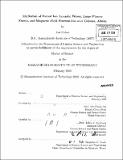Excitation of forced ion acoustic waves, large plasma sheets, and magnetic field fluctuations over Gakona, Alaska
Author(s)
Cohen, Joel (Joel A.)
DownloadFull printable version (25.69Mb)
Other Contributors
Massachusetts Institute of Technology. Dept. of Nuclear Science and Engineering.
Advisor
Min-Chang Lee.
Terms of use
Metadata
Show full item recordAbstract
Two research subjects: (1) excitation of "forced ion acoustic waves", and (2) "simultaneous excitation of plasma density fluctuations and geomagnetic field fluctuations" are reported in my M.S. thesis. The data was acquired in our experiments conducted at Gakona, Alaska from summer 2007 to winter 2008, using DoD/NSF-funded HAARP facilities and our own optical (ASIS) and radio instruments (VLF receiving system of IRIS) aided by GPS satellites as well as AMISR radar at Poker Flat, Alaska. We suggest that "Forced ion acoustic waves" detected by MUIR radar on Oct. 29 during 6:20-6:30 UT arise from keV electron precipitation associated with the occurrence of green aurora. Our work shows, for the first time, that MUIR radar is suitable for probing naturally occurring space plasma processes and not limited to HF heater-induced effects. This would extend the usage of MUIR for the investigation of space weather together with AMISR radar at Poker Flat, to advance our knowledge in space plasma turbulence. The research on "simultaneous excitation of plasma density fluctuations and geomagnetic field fluctuations" is an extension of my B.S. thesis research on thermal filamentation instability, which started in our summer Gakona experiments in 2005. Large plasma sheets (also known as sheet-like filaments) can be excited by HF O-mode and X-mode heater waves via thermal filamentation instability. (cont.) The dominant nonlinearity is provided by the differential Joule heating acting on electrons, which subsequently gives rise to a cross-field thermal pressure force, to concomitantly generate spatially varying plasma density fluctuations and geomagnetic field fluctuations. It is interesting to find that the fractional density fluctuations are approximately equal to the fractional magnetic field fluctuations. This gives us the theoretical basis to use ground-based magnetometer measurements to infer the density fluctuations in space plasma turbulence. Such a remote sensing technique for probing the space plasma is much more effective and economic than using a beacon satellite.
Description
Thesis (S.M.)--Massachusetts Institute of Technology, Dept. of Nuclear Science and Engineering, 2009. Cataloged from PDF version of thesis. Includes bibliographical references (p. 47-48).
Date issued
2009Department
Massachusetts Institute of Technology. Department of Nuclear Science and EngineeringPublisher
Massachusetts Institute of Technology
Keywords
Nuclear Science and Engineering.
